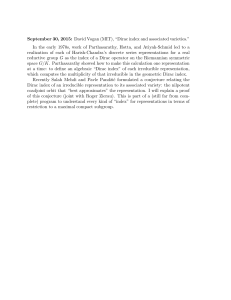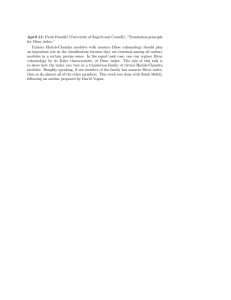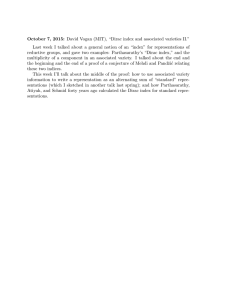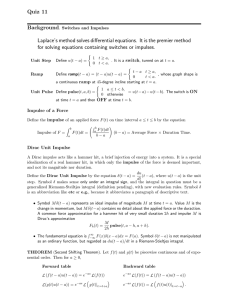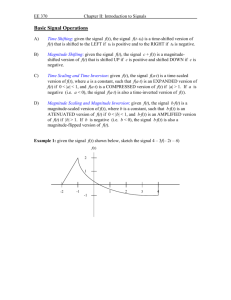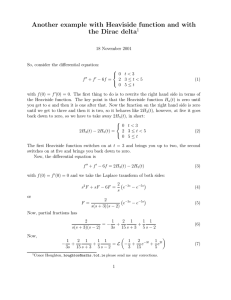8.6 Heaviside Step and Dirac Impulse Heaviside Function.
advertisement
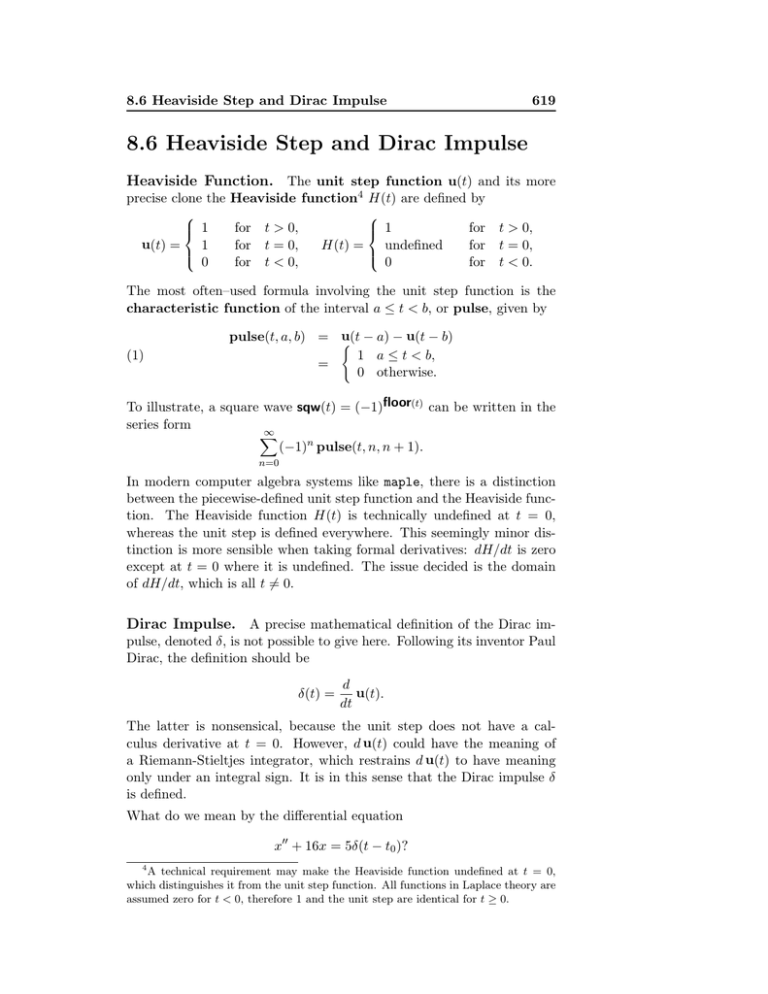
8.6 Heaviside Step and Dirac Impulse 619 8.6 Heaviside Step and Dirac Impulse Heaviside Function. The unit step function u(t) and its more precise clone the Heaviside function4 H(t) are defined by u(t) = 1 1 0 for for for t > 0, t = 0, t < 0, H(t) = 1 undefined 0 for t > 0, for t = 0, for t < 0. The most often–used formula involving the unit step function is the characteristic function of the interval a ≤ t < b, or pulse, given by (1) u(t − a) − u(t − b) pulse(t, a, b) = ( 1 a ≤ t < b, = 0 otherwise. To illustrate, a square wave sqw(t) = (−1)floor(t) can be written in the series form ∞ X (−1)n pulse(t, n, n + 1). n=0 In modern computer algebra systems like maple, there is a distinction between the piecewise-defined unit step function and the Heaviside function. The Heaviside function H(t) is technically undefined at t = 0, whereas the unit step is defined everywhere. This seemingly minor distinction is more sensible when taking formal derivatives: dH/dt is zero except at t = 0 where it is undefined. The issue decided is the domain of dH/dt, which is all t 6= 0. Dirac Impulse. A precise mathematical definition of the Dirac impulse, denoted δ, is not possible to give here. Following its inventor Paul Dirac, the definition should be δ(t) = d u(t). dt The latter is nonsensical, because the unit step does not have a calculus derivative at t = 0. However, d u(t) could have the meaning of a Riemann-Stieltjes integrator, which restrains d u(t) to have meaning only under an integral sign. It is in this sense that the Dirac impulse δ is defined. What do we mean by the differential equation x00 + 16x = 5δ(t − t0 )? 4 A technical requirement may make the Heaviside function undefined at t = 0, which distinguishes it from the unit step function. All functions in Laplace theory are assumed zero for t < 0, therefore 1 and the unit step are identical for t ≥ 0. 620 The equation x00 + 16x = f (t) represents a spring-mass system without damping having Hooke’s constant 16, subject to external force f (t). In a mechanical context, the Dirac impulse term 5δ(t − t0 ) is an idealization of a hammer-hit at time t = t0 > 0 with impulse 5. More precisely, the forcing term f (t) in x00 + 16x = f (t) can be formally written as a Riemann-Stieltjes integrator 5d u(t − t0 ) where u is the unit step function. The Dirac impulse or derivative of the unit step, nonsensical as it may appear, is realized in applications via the twosided or central difference quotient u(t + h) − u(t − h) ≈ dH(t). 2h Therefore, the force f (t) in the idealization 5δ(t − t0 ) is given for h > 0 very small by the approximation f (t) ≈ 5 u(t − t0 + h) − u(t − t0 − h) . 2h The impulse5 of the approximated force over a large interval [a, b] is computed from Z b a f (t)dt ≈ 5 Z h u(t − t0 + h) − u(t − t0 − h) −h 2h dt = 5, due to the integrand being 1/(2h) on |t − t0 | < h and otherwise 0. Modeling Impulses. One argument for the Dirac impulse idealization is that an infinity of choices exist for modeling an impulse. There are in addition to the central difference quotient two other popular difference quotients, the forward quotient (u(t + h) − u(t))/h and the backward quotient (u(t) − u(t − h))/h (h > 0 assumed). In reality, h is unknown in any application, and the impulsive force of a hammer hit is hardly constant, as is supposed by this naive modeling. The modeling logic often applied for the Dirac impulse is that the external force f (t) is used in the model in a limited manner, in which only the momentum p = mv is important. RMore precisely, only the change in momentum or impulse is important, ab f (t)dt = ∆p = mv(b) − mv(a). The precise force f (t) is replaced during the modeling by a simplistic piecewise-defined force that has exactly the same impulse ∆p. The replacement is justified by arguing that if only the impulse is important, and not the actual details of the force, then both models should give similar results. 5 Momentum is defined to be mass times velocity. RIf the force f is given by Newton’s b d law as f (t) = dt (mv(t)) and v(t) is velocity, then a f (t)dt = mv(b) − mv(a) is the net momentum or impulse. 8.6 Heaviside Step and Dirac Impulse 621 Function or Operator? The work of physics Nobel prize winner P. Dirac (1902–1984) proceeded for about 20 years before the mathematical community developed a sound mathematical theory for his impulsive force representations. A systematic theory was developed in 1936 by the Soviet mathematician S. Sobolev. The French mathematician L. Schwartz further developed the theory in 1945. He observed that the idealization is not a function but an operator or linear functional, in particular, δ maps or associates to each function φ(t) its value at t = 0, in short, δ(φ) = φ(0). This fact was observed early on by Dirac and others, during the replacement of simplistic forces by δ. In Laplace theory, there is a natural encounter with the ideas, because L(f (t)) routinely appears on the right of the equation after transformation. This term, in the case of an impulsive force f (t) = c(H(t − t0 − h) − H(t − t0 + h))/(2h), evaluates for t0 > 0 and t0 − h > 0 as follows: L(f (t)) = Z ∞ c 0 = 2h (H(t − t0 − h) − H(t − t0 + h))e−st dt Z t0 +h c −st e dt t0 −h = ce−st0 2h ! esh − e−sh 2sh esh − e−sh The factor is approximately 1 for h > 0 small, because of 2sh L’Hôspital’s rule. The immediate conclusion is that we should replace the impulsive force f by an equivalent one f ∗ such that L(f ∗ (t)) = ce−st0 . Unfortunately, there is no such function f ∗ ! The apparent mathematical flaw in this idea was resolved by the work of L. Schwartz on distributions. In short, there is a solid foundation for introducing f ∗ , but unfortunately the mathematics involved is not elementary nor especially accessible to those readers whose background is just calculus. Practising engineers and scientists might be able to ignore the vast literature on distributions, citing the example of physicist P. Dirac, who succeeded in applying impulsive force ideas without the distribution theory developed by S. Sobolev and L. Schwartz. This will not be the case for those who wish to read current literature on partial differential equations, because the work on distributions has forever changed the required background for that topic.

